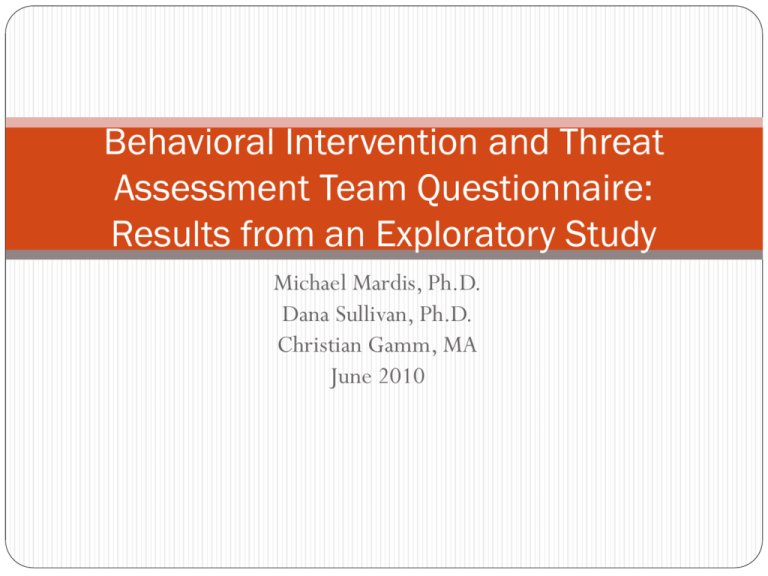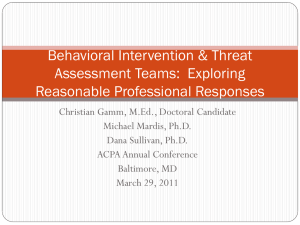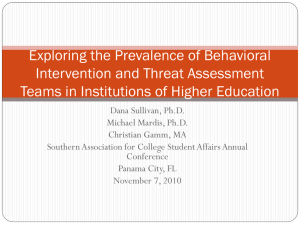Team 1 – 175 Responses
advertisement

Behavioral Intervention and Threat Assessment Team Questionnaire: Results from an Exploratory Study Michael Mardis, Ph.D. Dana Sullivan, Ph.D. Christian Gamm, MA June 2010 Presentation Agenda Introduction Impetus behind the creation of threat assessment teams Delworth Model 1989 Study Rationale Results Group Discussion Background On April 16, 2007, Seung-Hui Cho shot and killed 32 people and wounded many others on Virginia Tech’s campus, before committing suicide. On February 14, 2008, Steven Kazmierczak shot and killed five people and wounded 18 others before committing suicide at Northern Illinois University. Individual Campus Crisis Situations Due to recent tragedies at institutions of higher education, the reasonable professional response to managing at risk students has changed. Administrators are developing ways to best assist students and ensure a safe campus environment. Questions for those attending Does your campus have a team? Are you on your campus team? What is the Name? (BIT,TAT,SCT) When was your team created? Why was the team created? (Purpose) Do you have more than one team Do you keep records How do you maintain records Does your team receive training Institutional Liability Concern Negligence Duty Breach of Duty Proximate Cause Injury Courts have imposed a duty on colleges of protecting students from foreseeable harm. (Kaplin & Lee 2007) Privacy Laws Often there is confusion regarding what information on troubled students educators and mental health officials can share (Fischer & Wilson, 2007). Mental health professionals are allowed to share information in circumstances where they reasonably believe the client poses an imminent danger of serious injury to themselves or to others (Pavela, 2008). FERPA permits educators to share confidential information with law enforcement, medical personnel, and others without the student’s consent to protect the health and safety of others(Fischer & Wilson, 2007). BIT/TAT/SCT Team Often there is a clear lack of authority to fully manage threatening situations and to make critical decisions (Pavela, 2008) “Better communication about troubled students is needed,” so there is a need for a centralized approach to responding to these students(Fischer & Wilson, 2007). BIT/TAT/SCT Team Actuarial and clinical approaches to assessing threats can lead to false positives (Redden, 2008). According to the Office of Safe and Drug Free Schools, there is no “useful profile” for a school shooter. 93% of crimes students experience occur off campus (Cornell, 2008). Murder rate is 28 times higher off campus than on campus (Cornell, 2008). Terminology Students – troubled, at-risk, mental disability, disturbed, disruptive, distressed Definition of team – threat assessment team, behavioral intervention team, student care team, critical incident response team Over time will the profession come to a more standardized approach how these teams function and for what purpose (model BIT/SCT/TAT) Impetus for creating teams Research suggests the importance of “active engagement with troubled students sooner rather than later (Pavela, 2007).” Governor’s Report in wake of Virginia Tech shootings; prior to this incident, very few higher education institutions had threat assessment teams Extensive background regarding threat assessment at the elementary and secondary education levels. Risk avoidance Caring for students Roles Teams Detect and monitor potentially violent students (Dunkle, Silverstein, & Warner, 2008) Monitor other students who may be troubled or troubling in other ways (Dunkle, Silverstein, & Warner, 2008) Engage troubled students as early as possible, helping them receive appropriate professional help (Pavela, 2008) Coordinate response efforts of multiple units Delworth Model of Threat Assessment Created in 1989 Also referred to as a framework, the Assessment-Intervention of Student Problems (AISP) model 3 components Formation of campus assessment team General assessment process for channeling students into the most appropriate on/off campus resources Intervention with the student of concern Delworth Model of Threat Assessment From Jablonski, McClellan, & Zdziarski, 2008 Flowchart for Managing Disturbed and Disturbing Students From Jablonski, McClellan, & Zdziarski, 2008 References Cornell, D. (2008). No title. NASPA Leadership Exchange. Delworth, U. (1989). Dealing with the behavioral and psychological problems of students. San Francisco: Jossey-Bass. Dunkle, J.H., Silverstein, Z.B., & Warner, S.L. (2008). Managing violent and other troubling students: The role of threat assessment teams on campus. Journal of College and University Law 34(3), 585-636. Fischer, K., & Wilson, R. (2007). Review panel’s report could reverberate beyond Virginia Tech and Virginia. Chronicle of Higher Education 53. Kapplin, W. & Lee, B. (2007). The Law of Higher Education Student Version. San Francisco. JosseyBass Pavella, G. & Joffe, P. (2007). Responding to troubled and at-risk students. NASPA Webinar. 10/9/2007. Pavella, G. (2008). Colleges won’t help students by fearing them. Chronicle of Higher Education 54(25), A37. Redden, E. (2008). Predicting and preventing campus violence. Inside Higher Ed.com, 4/7/2008. Reasons For the Study RESULTS - Response Rate 1044 institutions invited (Sent to SSAO) 51 undeliverable email 993 invitations, 181 responses 18% response rate Do you have a team designed to respond to students in crisis or at-risk -175 indicated having a team to respond to students in crisis/distress. 5 No team, 1 not sure 60 institutions (34% had had more than one team) 8 institutions had 3 teams Only institution indicated having 4 teams (BIT, Conduct Review Board, Critical Incident Team, Emergency Management Team) Demographics Type of Institution Demographics Type of Institution Demographics Type of Institution 19% 25% Community or Technical 35 Religious Affiliated 45 Demographics Type of Institution Was your team created to minimize liability based on risks associated with recent high profile violent acts committed on campuses? (M = 3.04, SD = 1.11) 100 90 80 70 60 50 40 30 20 Strongly Disagree 8% 10 0 Disagree 27 % Neutral 27% Agree 30% Strongly Agree 8% Confidence in the Team’s Meeting Institutional Expectations (M = 3.90, SD = .79) 100 90 80 70 Confident 53% 60 50 Moderately Confident 21.5 40 30 20 10 0 Not at all Confident2 .5% Limited Confidence 4% Very Confident 21% Confidence that by implementing teams your institutions is meeting reasonable professional standards to effectively manage legal liabilities (M = 3.91, SD = .8) 100 90 80 70 Confident 53% 60 50 40 30 20 10 0 Not at all Confident 1% Limited Confidence 4% Moderately Confident 20% Very Confident 22% Overall Effectiveness of Team in Addressing Threat Assessment or Behavioral Intervention on Campus (M = 3.95, SD = .75) 100 90 80 Effective 57% 70 60 50 40 30 20 10 0 Not at all Effective 0% Limited Effectiveness 5% Moderately Effective 17% Very Effective 21% Length of time in Existence in Years (Team 1 – 175 Responses) Mean = 4.26 Minimum = .50 years Maximum = 30 years Median = 3 years Team 1 A rose by any other name would smell as sweet Student Crisis Action Team (SCAT) Communicating Action Response for Emergency (CARE) Care and Action for Students Team (CAST) Student Protection Response Team (SPRT) Action for Students In Suffering Team (ASIST) Ensuring Action for Students in Emergency (EASE) Action Crisis Team for Students (ACTS) Care Team Most common team name Behavioral Intervention Team Most Frequently Occurring Responsibilities for Team 1 • Making referrals for students in crisis (n = 164) • Assessing at-risk students (n = 163) • Sharing information among appropriate offices (n = 167) • • • • Responding to a crisis that threatens the well-being of a student or students (n = 153) Ensuring appropriate follow-through with students (n = 154) Responding to student behavior that is disruptive to the university community (n = 151) Identifying student behaviors that disrupt the learning environment (n = 142) • Keeping records on students considered “at-risk” or who are in crisis (n = 132) • Serving as a source of information to faculty and staff (n = 126) • Initiation of internal review of the crisis situation (n = 112) • Responding to incidents where the person of concern is a faculty or staff (n = 96) • Dealing with students with academic difficulties (n = 52) • Other functions (n = 12) Situations Most Frequently Addressed (Team 1) Threats of Violence to Others (n = 165) Classroom Disruption (n = 149) Emotional Distress (n = 158) Stalking Behaviors (n = 146) Suicidal Threats (n = 156) Diagnosed Mental Health Disorders (n = 129) Inappropriate Communications (n = 150) Failing Grades (n = 49) Financial Difficulties (n = 40) Identified Team Members (175 respondents) Counseling Center Director (153) Director of Dept. of Public Safety (139) Housing Director (125) Dean of Students (114) * Student Conduct Officer (112) Health Services Director (81) Faculty Rep (72) VP of Student Affairs (61) Others Identified (125) Academic Advising, Financial Aid, Disabilities Office Rep., Legal Counsel, University Ministry, Athletics, International Office, Women’s Services, Registrar, Wellness Director, Career Services Titles vary at types of institution (DOS and VPSA) *most frequently identified chair (DOS 72, VPSA 44, Other 38, Counseling Director 20) Team Training 67.24 % Receive Training 32.76 % No Training Types of training In house (VPSA, Legal Council, DOS, Police,Counseling Center) Webinars Workshops Conferences, NaBITA (National Behavioral Intervention Team Association) Brett Sokolow Audio Online Seminar BIT MAGNA Publications 1. Why do we need a BIT? 2. Who should be on our team? 3. Is there an ideal team size? 4. How often should the team meet? 5. What are BIT recordkeeping best practices? 6. What is the ideal function of a BIT? 7. Who performs actual interventions? 8. What should a BIT protocol include? 9. How formal should the BIT operations be? 10. How transparent should BIT operations be? 11. What should be reported to the BIT? 12. Who should report information to the BIT? 13. How should information be reported to the BIT? 14. What feedback should reporters receive from the BIT? 15. How should the BIT communicate with the campus, and about what? 16. What is the role of the counselor(s) on the BIT? 17. Who should chair the BIT? 18. What are post-intervention best practices? 19. How can a BIT foster a culture of reporting? 20. How does a BIT successfully address privacy/confidentiality concerns? Team Meetings Frequency % Weekly 31% As-Needed 29% Twice Monthly 24% Monthly 10% Other 6% Record Keeping Does your team keep records of meetings? 79% Yes 21% No Does your team keep records of the specific students you’ve discussed? 94% Yes 6% No Record Keeping: How teams keep records of information discussed at meetings. Notes (personal, informal) Meting minutes Programs (conduct software, Maxient software, Excel, Titanium) Student files (DOS, Conduct, Counseling Center, Univ Police) Shared Electronic Folder List of students names and date discussed only Individuals maintain records Record action items only How do you make others aware of your team? TOP RESPONSES Visits to units/departments (n = 102) Campus electronic notification to faculty staff (n = 99) Website (n = 65) Brochure (n = 39) Campus electronic notification to students (n = 37) Other: don’t make others aware, we don’t promote, faculty senate, Chairs meeting, faculty training, peer education Team 2 (n= 41) Team 2 Length of time in Existence in Years Mean = 3.8 Minimum = .50 years Maximum = 30 years Median = 3 years Function Behavioral Intervention 12% Threat Assessment 32 % Information / Referral 5 % Student Care 27 % Academic 5 % Discussion Next steps as a profession Where do we see this going (What is the future) Resources (Time & Funding) What are the implications for us as practitioners Risk avoidance and liability issues – what can we do, what should we be doing, and what are we saying we can do with these teams Discussion Record Keeping/Documentation Centralized or Decentralized Formal informal Access to information Record keeping who has access from institution Staff Training Parental Notification Communication with Campus How are you sharing information Privacy Laws Membership Areas for future study Questions for those attending Does your campus have a team? Are you on your campus team? What is the Name? (BIT,TAT,SCT) When was your team created? Why was the team created? (Purpose) Do you have more than one team Do you keep records How do you maintain records Does your team receive training Contact Information Michael Mardis Dean of Students Associate VP 502.852.5787 m.mardis@louisville.edu





